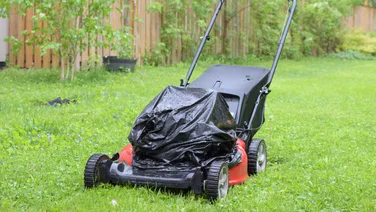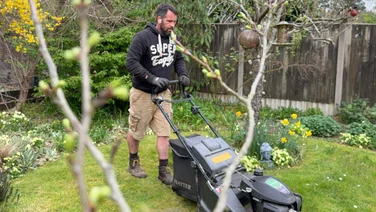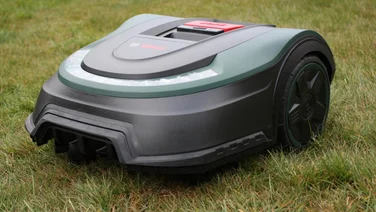To help us provide you with free impartial advice, we may earn a commission if you buy through links on our site. Learn more

Against a backdrop of historically high energy bills, many of us are paying closer attention to the running costs of our power tools and home appliances.
The good news for gardeners is that electric lawn mowers are fairly inexpensive to power and maintain, relative to other home appliances that are used more frequently. Most UK households pay an energy cost of around £0.10 – £0.30 per mow, depending on factors including lawn size and lawn mower wattage.
All types of electric lawn mower, whether cordless, corded or even robotic, will usually be cheaper to run than a petrol-powered mower. In this guide, we take a close look at the running costs of an electric lawn mower, so read on to learn how much maintaining your lawn is likely to set you back this spring or summer. Along the way, we’ll include some tips on how to reduce lawn mower running costs.
Corded electric lawn mower running costs
The energy cost of running a corded electric lawn mower is relatively simple to work out since the key factors are just the wattage of the lawn mower and the cost of energy supplied to your household.For example, if your mower has a 1,000W motor and it takes you about 30 minutes to mow your lawn, then the energy cost of a single mow would be around £0.15, based on the average UK household’s current energy rate of £0.29/kWh (kilowatt hour).
Of course, if you have a larger lawn that takes longer to cut, or a smaller lawn that you can mow more quickly, your running costs will be proportionately higher or lower, respectively. Similarly, the amount of power the lawn mower’s motor uses – given in watts (volts multiplied by amps) – will affect how much you would expect to pay. So, if your cordless lawn mower has a 900W motor, it should use less electricity than a 1,200W mower would use over the same amount of time. However, there’s a trade-off here as a more powerful lawn mower will often have a greater cutting width, meaning it should be able to mow the lawn faster.
Most lawn mowers are rated between 900W and 1,500W, which is fairly similar to a microwave or a high-powered washing machine. If you’re still happy to run those appliances day-to-day, you shouldn’t be too concerned about the cost of using your lawn mower every now and then.
READ NEXT: Best lawn mowers
Cordless electric lawn mower running costs
Cordless lawn mowers are powered by rechargeable lithium-ion batteries, so the cost of charging these batteries determines the running cost of the mower.
Relative to most other cordless power tools and appliances, such as basic combi drills or vacuum cleaners, lawn mowers use electricity at a high rate to run their high-powered motors. As a result, many cordless lawn mowers use two lithium-ion batteries – whereas most other tools only use one battery at a time – reducing the risk of running out of charge before the mowing is completed.
Let’s say you need to charge two 4.0Ah batteries to run your cordless electric lawn mower. If each battery is charged using a 2.0Ah charger, then it would take a total of four hours of charging time to fill both batteries. If the battery charger runs at 200W, then 0.8kWh of mains electricity would be consumed, costing you about £0.23 to charge both batteries.
Most gardeners would hope to have some charge left in their mower’s batteries after a single mow so, conservatively, you’re looking at paying under £0.20 per mow with a cordless electric lawn mower.
The above assumes that both the charger and the batteries are working efficiently but, as we’ll see, this isn’t always the case.
READ NEXT: Best lawn mowers for small gardens
Why do lithium-ion battery charging costs vary so much?
The cost of charging a lithium-ion battery depends on a variety of factors, including:
- Capacity: How much charge does the battery hold? This is measured in amp-hours (Ah).
- Voltage: How powerful is the battery? This is measured in volts (V). 12V and 18V batteries are commonly used with cordless lawn mowers.
- Electricity rate: How much do you pay per kilowatt hour of electricity? According to Ofgem, the typical UK household is paying £0.29/kWh as of the start of 2024.
- Efficiency of the battery and its charger: Efficiency varies by model and condition and will decrease over time as its internal components degrade and their electrical resistance increases.

As a lithium-ion battery degrades as it ages, the cost of keeping it charged goes up – and the cost of mowing the lawn grows too – however, you can slow the rate of degradation in your batteries by following a few smart measures:
Store batteries at a suitable temperature – Most manufacturers recommend batteries are kept between about 10 – 20 ℃, so it’s best to keep batteries inside the home, rather than inside an unheated space such as a shed, and away from heat sources, such as radiators. Check the manual for guidance specific to your battery.
Don’t leave batteries in direct sunlight – This reduces the risk of overheating.
Keep batteries moderately charged – Lithium-ion batteries deteriorate more slowly when they are partially charged (between 20% and 80%) than when they are full or depleted.
Top up with charge over the winter – Fairly regular use helps keep lithium-ion batteries in good working order. Consider charging yours for short periods over the winter, even if there’s no mowing to do – lithium-ion batteries lose charge gradually while they’re not in use so, really, you’re just topping them up.
Eventually, your mower’s lithium-ion batteries will stop working, or become so inefficient that using them is no longer practical. This often happens after about five years; some owners may be able to keep their lithium-ion batteries functioning for longer by following these best practices.
You are likely to need to replace your cordless mower’s batteries at least once or twice in its lifetime. A pair of new 4.0Ah batteries will set you back around £150, effectively adding £30/year onto the mower’s running costs, though this extra would be a lump sum and not spread out over time.
On the bright side, the lithium-ion battery packs compatible with lawn mowers can often be used with other tools from the same brand. So, you can get more use out of them than just powering your lawn mower, particularly if you’re partial to a spot of DIY.
READ NEXT: Best cordless strimmers
What about robot lawn mowers?
Robot lawn mowers are often less powerful than walk-behind models, cutting gradually as they traverse the lawn. Platt’s Robotics estimates that the average robot racks up just a few pounds per month in energy costs.

In terms of cost, the main downside to using a robot mower is that it tends to come at a high up-front price. Our favourite budget model, the Yard Force EasyMow 260B, costs around £350, but many premium robot mowers will set you back over £1,000. The energy costs of any lawn mower pale in comparison to such an investment.
Tips to reduce your lawn mower running costs
Mow less often
Frequent mowing is key to keeping your lawn short, neat and tidy at all times. However, gardeners who are open to having a more natural-looking lawn can significantly reduce their running costs by mowing less often – even if that just means taking a ‘no-mow’ break during the spring or summer.
Mowing half as often won’t quite halve your energy use, as longer grass takes more time and power to cut. Nonetheless, you’ll still use less electricity overall.
Use high-powered features sparingly
Some electric lawn mowers have features such as ‘power assist’, which reduces the amount of effort required to push the mower, and higher mowing speeds. While these features can be very useful – and for some users they might even be essential – they tend to increase energy usage. If your priority is to cut the cost of operating your lawn mower, then using such high-powered features less often will reduce your energy consumption.
Take care of your lawn mower
Looking beyond ordinary running costs, some of the biggest expenses occur due to repairs, and even replacement, of broken mowers. Taking good care of your lawn mower will reduce the likelihood that expensive lawn mower repairs will be required.
Some positive steps include:
- Clean out the mowing deck after each mow using a cloth or stiff-bristled brush. This will prevent the build-up of debris and reduce the risk of rusting. Be careful of the mower’s blade while you work and always disconnect the mower from the power supply first.
- Avoid cutting grass while it is wet. Wet grass takes more effort to cut, which can put the lawn mower and its components under unnecessary stress.
- Always store the mower in a dry place, particularly during the winter, and ideally under a waterproof covering.
- Sharpen your mower’s cutting blade once or twice per year, as a sharp blade is more efficient.






